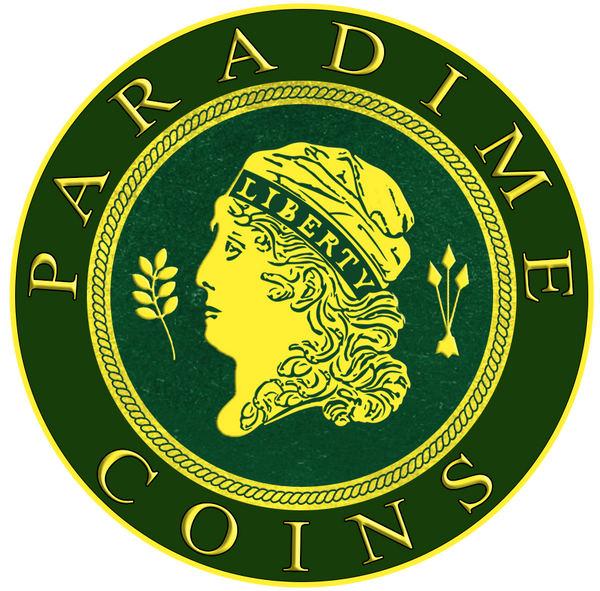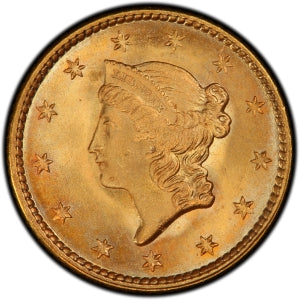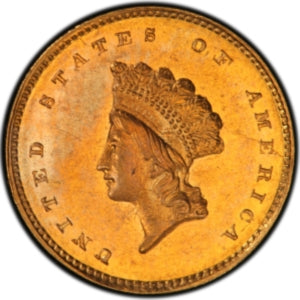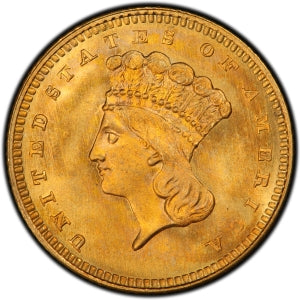Collection: Gold Dollar (1849 - 1889)
No products found
View All Inventory
Gold Dollar (1849–1889): A Small Coin with a Rich History
The Gold Dollar, the smallest denomination of U.S. gold coinage, was introduced in 1849 as a response to the California Gold Rush. Its creation coincided with the launch of the Double Eagle, addressing the nation's influx of gold. Despite its ... Read More
Gold Dollar (1849–1889): A Small Coin with a Rich History
The Gold Dollar, the smallest denomination of U.S. gold coinage, was introduced in 1849 as a response to the California Gold Rush. Its creation coincided with the launch of the Double Eagle, addressing the nation's influx of gold. Despite its modest size, the Gold Dollar holds significant historical value and remains a favorite among collectors.
Key Specifications
- Designers: James Barton Longacre
- Issue Dates: 1849–1889
- Composition: 90% gold, 10% copper
-
Diameter:
- Type I: 13 mm
- Types II & III: 15 mm
- Weight: 1.67 grams (25.77 grains)
- Edge: Reeded
Historical Background
The Gold Dollar was initially introduced as a practical solution for everyday transactions during the Gold Rush. Its small size and high value made it a popular denomination, especially in the East and South. Production continued until 1889, although mintages dwindled after the Civil War due to declining public demand. Today, collectors focus on its three distinct design types.
Three Types of Gold Dollars
Type I: Liberty Head Gold Dollar (1849–1854)
-
Design:
- Obverse: Miss Liberty with a coronet inscribed "LIBERTY," surrounded by 13 stars.
- Reverse: Wreath enclosing the denomination and date, with "UNITED STATES OF AMERICA" around the border.
- Diameter: 13 mm (smallest U.S. coin ever issued).
- Mintage: 12,565,273 business strikes.
-
Highlights:
- Produced at multiple mints, including Philadelphia, New Orleans, Dahlonega, and Charlotte.
- Scarce branch mint coins (Dahlonega and Charlotte) are highly sought after.
Collectors will find Philadelphia-minted coins readily available in grades from Very Fine to AU, with Uncirculated examples being scarcer.
Type II: Small Head Indian Princess (1854–1856)
-
Design:
- Obverse: An Indian princess wearing a feathered headdress.
- Reverse: Wreath of corn, wheat, cotton, and tobacco.
- Diameter: 15 mm (increased for practicality).
- Mintage: 1,633,426 business strikes.
-
Key Features:
- Known for striking issues, with weak central details due to the high-relief design.
- Rarest of the three types, with notable rarities like the 1855-C and 1855-D.
Type II Gold Dollars are the most challenging to acquire, especially in higher grades, making them a prized piece for collectors.
Type III: Large Head Indian Princess (1856–1889)
-
Design:
- Obverse: Indian princess motif in lower relief for improved striking.
- Reverse: Modified wreath design.
- Diameter: 15 mm.
- Mintage: 5,327,363 business strikes.
-
Key Highlights:
- Struck consistently until 1889, though mintages dropped sharply after the Civil War.
- Rare issues include the 1875 (400 business strikes and 20 Proofs).
Type III Gold Dollars are more accessible, with many surviving in Uncirculated condition due to speculative activity in later years.
Why Collect Gold Dollars?
- Historical Value: Represents a pivotal era in U.S. history, including the California Gold Rush and post-Civil War recovery.
- Variety: Offers three unique designs for collectors to pursue.
- Scarcity: Type II Gold Dollars, branch mint coins, and Proof issues add challenges for advanced collectors.
- Investment Potential: High-grade examples and rarities like the 1855-D or 1875 command significant premiums.
Explore Gold Dollars at ParadimeCoins.com
ParadimeCoins.com offers a wide selection of Gold Dollars, from affordable Type I examples to elusive Type II rarities. Whether you're building a type set or seeking a standout piece, our inventory is curated to meet the needs of collectors at every level. Celebrate the legacy of America’s smallest gold coin—shop with us today!
... Read Less







